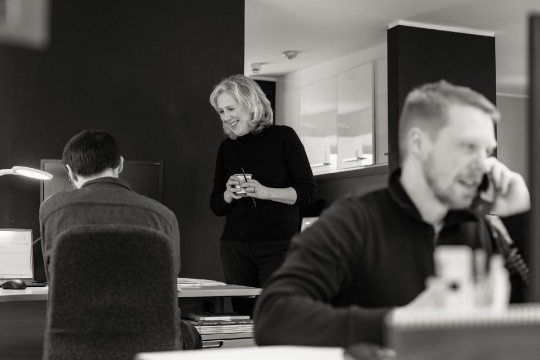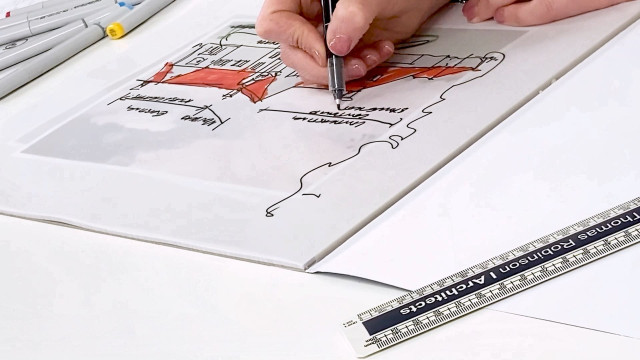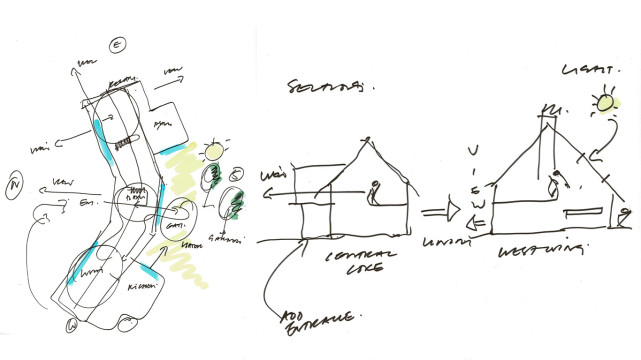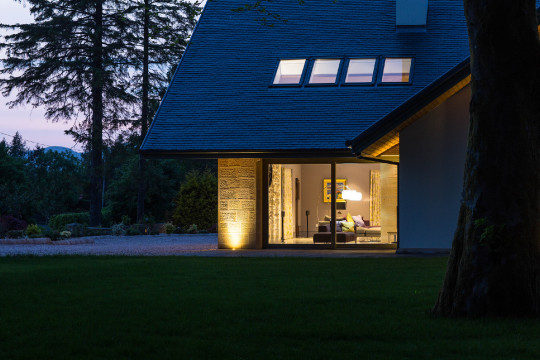DESIGN SPOTLIGHT: WHY OUR DESIGNS WORK
23rd August 2023DESIGN SPOTLIGHT – WHY OUR DESIGNS WORK
by Fiona Robinson, Practice Director
Beautiful architecture makes us all feel better. Our goal is to create those beautiful buildings that make our clients feel great. Over the years here at Thomas Robinson Architects, we have honed our service into one where we know our designs will be successful. That means each finished building will look elegant and stand firm, will feel good to be in and will exude that extra-special atmosphere that the best designs offer.
Although I want the effects of our design process to be almost subliminal for the client, I find it interesting that many architects don’t approach design in the same finely tuned way that we do.
While it may appear that there is a magical alchemy in getting a house to this end point – where it’s the best it can be, it’s actually the result of a careful and practised way of working.

Part of the path to success is having the right people doing what they’re best at. In our practice we understand which people bring which elements of success to the process; we don’t try to bang square pegs into round holes.
GETTING A HOUSE DESIGN RIGHT FROM THE START
I work at the start of the architectural process of every project. Where I excel is the niche exercise of applying my design processes to ensure that you’ll love your building and will feel good in it. This involves hidden moves by me, which ensure that at the end of it you will love your building, but you won’t necessarily know why.
Those hidden moves have become so attuned over time that they feel innate. But I’ll give it a go to explain what my process is.
Once we’ve got the essence of the brief from the client, I’ll do a site visit to start to think about
positioning and orienting the build or extension. This is also partly about feel and about understanding where the best spots are on the site and why – where sunlight hits at different times of day, what will work in the setting and with any surrounding architecture, and what the views will look like of and from the finished building.
Then I get to work with my black felt pen and blank sheet of paper. Drawing is so integral to how I develop my design ideas that I’m known for always carrying a pen and pad. I find that a quick sketch can get across an idea that a hundred words can’t.

Of course, we have plenty of high-tech computer-aided design wizardry in the office, with expert members of the team producing 3-D designs, walk-through 360˚ plans and more as the design develops, but I have yet to find a better start to the process than my trusty pen and paper.
BACK TO DESIGN BASICS
At this early point we will have created a computerised plan of the plot – a building that’s already there if we’re extending and of anything that surrounds the site, from neighbouring buildings to rivers, trees, roads and hills. Back in the office, I’ll work away with sheets of tracing paper on top of those plans. I’m seeing how to fit in the design in the best possible way.
What’s going through my head at this point is a series of things.
I’m thinking about North, South, East and West – about sunlight, about scale, proportions and appearance of what we’re going to create. And I’m thinking about the house as part of its landscape and responding to that. I’m also already considering the building’s internal flow, which is so important to how it feels.

Much of this process is instinctive – I have an accurate feel for what will work. But at the root of the decision-making is a series of influences.
These include the ideas discussed at our first client meeting and all the information we have gathered from the site and about how the client wants to live. Other minds on the design team will have started whirring, but when it’s just me and that sheet of paper, that’s when I really focus and start to develop my creative thoughts.
These sketches will quickly change and be added to, as I work out what will work and what won’t. It’s much easier for me to visualise those decisions using paper and pen.
There may be issues that arise early on which need another meeting with the client and the rest of the design team. Something that they imagined would be right may have a hidden snag that I’ll have found in the drawing and research process. What I know is that getting things right at this early stage is what lays the foundations for a successful project.
Later on in the process I take a more back-seat approach, and others bring their skills to the table. But we’re always a team, there to be brought back together to problem solve and create.
THE HIDDEN PILLAR OF ARCHITECTURE
While much architectural discussion is about practical issues, such as how to get planning, budget and what sort of kitchen you want, I feel the more esoteric subject of how a house will feel is a real key to great design.
Of course, there are all manner of tricks that us architects know how to make work with certain measurements, balance and approaches, but that ultimate question, ‘What will it feel like to be in this house?’ is perhaps the one I spend most time on. It’s in answering that that the best design emerges.
How a building feels to be in is crucial to its success. When you enter a mansion house, do you want to step into a small confined hallway cluttered with coats, or into an impressive atrium, where there is space all around and an obvious path into the rooms ahead? When you’re in the open-plan kitchen-dining-living room of a newly renovated Victorian villa, do you have to think where the obvious place to sit to enjoy a coffee is, or is it just there, without you having to think about it? And imagine a large window that frames the best view of the house – that is something you will always be drawn to for pleasure.

BUILDING RELATIONSHIPS
Building a relationship with our clients is another key factor in getting a successful result. We spend a lot of time with our clients who are building their dream home. They’ve been inspired by places and pictures and are on a life’s mission to create the perfect home for themselves.
Perhaps they dream of living in a modern farmhouse with rolling views, a perfect lochside lodge, or a listed Scottish mansion. They imagine themselves in that house and what their lives would be like. (In my case the dream is a luxury Alpine Chalet, from which I’d ski out of, then return for a hot bath, relax over a drink and a lovely meal with the family. I want the whole package, the south facing balcony, the old look and the easy access.)
I understand this desire, and I think what we can provide is the solution for that dream – we’re the trusted partner for this process, because we really take time to understand our clients’ goals and lifestyle. Then, through our consistency, honed processes, skilled design team and book of trusted partners, we make that dream happen.

